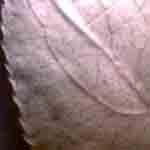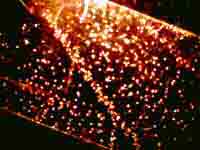Viburnum
key home
Topics on
this page:
Teeth spacing
Leaf surfaces
Magnification
Guide to viburnums by David Swaciak.
Leaf drawings by
Marcia Eames-Sheavly.
Logo
images by Paul Weston & Craig Cramer
|
Use the information below to help guide your observations as you identify which species of viburnum you have.
Teeth
Spacing
Most viburnums have teeth along the margin. Place
the leaf margin over the middle of a dime. Count the number of teeth
within this span.
|
Teeth
closely spaced
10 or more/dime
|
Teeth
widely spaced
9 or less/dime
|
|
|
|
Top
Leaf
surface
Many viburnums have pubescence (hairs) on the underside
of the leaf. Others are glabrous (smooth) on the underside. Some
have hairs only along the veins while the rest of the leaf is smooth. Still more have
small brown or black dots.
Here are two ways to determine
pubescence.
- Examine
the leaf or twig with a handlens. Under 10x magnification,
to see the following characteristics:
|
|

Glabrous
- With hairs only on veins
|
 Glabrous
- no hair Glabrous
- no hair |
|
|
|
- Here's another way to detect pubescence:
- Firmly press cellophane
 tape over the surface of the leaf that you want to check for pubescence. tape over the surface of the leaf that you want to check for pubescence.
- Remove tape.
- Lay tape over black paper.
- Observe with a hand lens to see if tiny hairs are present on tape surface (right).
Top
Magnification
 Some of the observations you need to make in this guide will be much easier if you use magnification. Some of the observations you need to make in this guide will be much easier if you use magnification.
A hand lens or magnifying typically provides 5x (times) or 10x magnification. They can often be purchased in drug stores.
A loop or dissecting scope provide higher magnification, usually 20x to 30x. Camera stores often have inexpensive loops. Check with a local biology teacher to see if you can borrow a dissecting scope.
If none of these are available you can use a pair of binoculars with
removable lenses. The front lens, when unscrewed from the housing,
can be used as a hand lens. Be sure to get permission from parents
or the owner of the binoculars before you take them apart.
Top
© Copyright, Department of Horticulture, Cornell University.
Project coordinator: Lori Brewer, ljb7@cornell.edu
Website design: Craig Cramer cdc25@cornell.edu
Mention of trade names and commercial products is for educational
purposes; no discrimination is intended and no endorsement by Cornell
Cooperative Extension or Cornell University is implied. Pesticide
recommendations are for informational purposes only and manufacturers'
recommendations change. Read the manufacturers' instructions carefully
before use. Cornell Cooperative Extension and Cornell University assumes
no responsibility for the use of any pesticide or chemicals. Some
of the links provided are not maintained by Cornell Cooperative Extension
and Cornell University. Cornell Cooperative Extension and Cornell
University are not responsible for information on these websites.
They are included for information purposes only and no endorsement
by Cornell Cooperative Extension or Cornell University is implied.
Cornell Cooperative Extension provides equal program and employment
opportunities. |